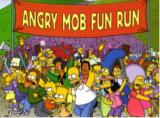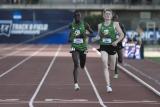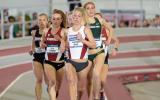Folders |
Mile vs. 1500m: After the Vote, the Debate is Still On
Published by
This morning, the US Track & Field and Cross Country Coaches Association voted to recommend to the NCAA Track & Field Committee that the mile replace the 1500m at NCAA Division I Championships. The vote was driven by the Bring Back the Mile campaign, which sees the mile and its iconic sub-4 minute mark as a powerful branding and fan engagement tool for track & field. For most of BBTM’s existence, its initiatives and support for the sport received universal acceptance among athletes, meet directors and others. Soon after announcing the result of the USTFCCCA vote, though, several professional athletes took to Twitter to voice their displeasure with the possibility of the mile replacing the 1500m in the NCAA. The criticisms ranged from matters of race tactics to questioning the very premise of BBTM’s campaigns. In light of the somewhat surprising mixed reaction, let's explore some of the points raised by both sides and compare them to similar situations in other sports. Competitive Tactics in the Mile & 1500m
Other athletes echoed the difficulties in obtaining their preferred position when starting on a turn. Athletes in all sports have to adapt their individual and team tactics based on rules instituted to make the game more entertaining, safer or more competitive. The introduction of the shot clock in basketball and hockey’s frequent iterations of the 2-line pass and “touch-ups” for an icing call are a few examples from major American sports where the leagues changed the rules. Obviously, the players and coaches - perhaps after some grumbling - adapted. Amateur-to-Pro TransitionSome athletes noted that competing in the mile would lessen their opportunities to qualify for international and national championships, particularly in an Olympic year. Because they would have fewer 1500m races they would have fewer chances to set a qualifying mark. This concern is particularly poignant in track & field, where few athletes have the opportunity to train with the same level of dedication and commitment post-collegiately as they do when they are students given the limited facilities and necessity to have outside employment. Beyond the given year, though, competing the mile in college and the 1500m professionally would be at most a comparable transition relative to those found in other sports. Collegiate baseball players must make the shift from aluminum bats to wood bats when they turn pro. Basketball players need to adapt to a 24 second shot clock from a 30 second shot clock (which was 35 seconds until last year).
Fan EngagementBring Back the Mile’s top-line argument is that Americans (a) understand the mile, and (b) recognize the 4-minute mark in a way that can never be duplicated by the 1500m. Changing the distance to something instantly understandable and that has a historical benchmark would reduce a barrier to entry for a new fan. Referring to tactical championship races in the NCAA, Jeremy Rae of Speed River Track & Field Club said:
This would be a complete backfire for BBTM, as their attempts to link the mile to the 4-minute barrier would serve only to show casual fans how “slow” a race was. A cautionary tale for BBTM is in Major League Soccer. When MLS prepared for its 1996 launch, the league struggled to make the sport more amenable to American fans. Equally important was knowing to what extent they could change the sport without alienating existing soccer fans. One initiative was to change the game clock to a countdown clock. Traditionally in soccer, the game clock starts at 0:00 and goes up. Because this was foreign (literally) to most American sports fans, and had no bearing on how the game is played, MLS thought it would be a painless transition. As it turned out, many Americans still did not like soccer regardless of how the clock moved. Fans were turned away more by 0-0 on the scoreboard than they were attracted by 0:00 on the game clock. Existing soccer fans saw the change as pandering to non-fans at the expense of the game’s traditions and the loyalty of those who already loved soccer. They wanted to be fans of American soccer, not the American version of soccer, and felt sold out. MLS created a lose-lose situation, and after 3 years of struggling audience numbers, instituted the traditional “count-up” clock. Is It Worth the Extra 109 Meters?BBTM has explicitly - and, today, repeatedly - said that replacing the 1500m with the mile would be merely one step in the right direction, and in no way is a cure-all for the sport. These sorts of changes are a healthy and necessary part of any sport, and the fact that track & field has undergone so few substantive changes over the years should give us pause. The sport’s resistance to change, coupled with its apparent dismissal of lessons learned from the broader sports marketplace, are at the root of many of track & field’s current, decades-old struggles.
The idea that racing the mile in college (or more broadly in American track meets) will disadvantage US athletes when it comes to national and international qualifiers reinforces the need to sever the sport from the Olympic paradigm. The rules of international (Olympic) hockey differ from the rules of the National Hockey League. Playing in the NHL does not limit an athlete’s options of playing in the Olympics because the rules are complementary and the athletes make the necessary adjustments every 4 years. Both sides accommodate. Far more importantly, the NHL competes every year, is the source of athletes' income and is the pinnacle of the sport the world over. If a hockey player was asked to choose between his year-in, year-out source of income and competition and a quadrennial event, we all know which way he would choose.
A sport cannot thrive - and in today’s marketplace, can barely survive - when it is based on a non-annual event with a limited number of athletes and a cartel-like business structure. American track & field athletes deserve an alternative system, and the Olympic-based structure of track & field deserves to be challenged in such a way. However, this will require a shift in athletes’ mindset as well as a novel business creation to attain success.
BBTM should be praised for thinking of the fans first. A sport cannot exist for the athletes, unless it is comfortable having few fans and even less money. If the fans are willing to pay to watch a race - whether it is 1500, 1609 or 1874.6 meters -then athletes will either have to compete that race or make their peace with not getting paid. But all stakeholders must be accounted for and all scenarios must be foreseen. Rae’s concern about a fan having a full understanding of a 4:15 mile is a compelling example of how seemingly foolproof ideas can have unintended consequences.
Pro track & field has very few recognizable attributes, and even fewer are positive. The sub-4 minute mile is one of them. As a sport, we should be very cautious before we once again allow our past to trip up our future. |









